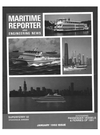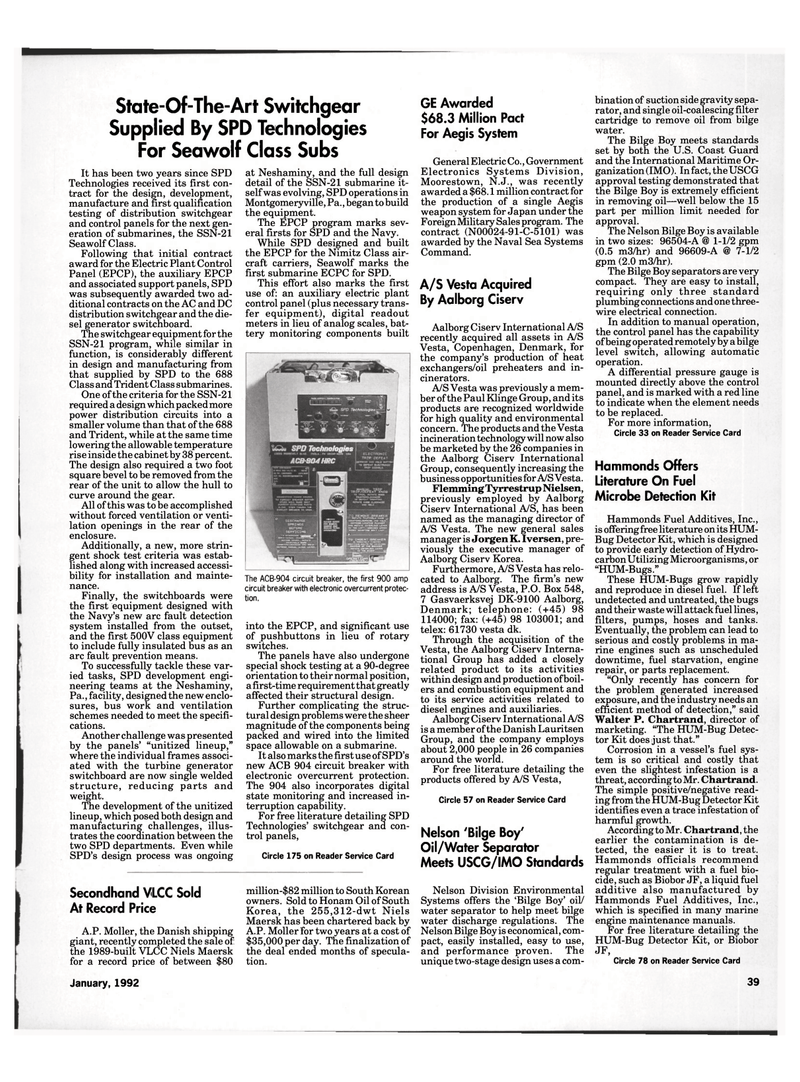
Page 37: of Maritime Reporter Magazine (January 1992)
Read this page in Pdf, Flash or Html5 edition of January 1992 Maritime Reporter Magazine
State-Of-The-Art Switchgear
Supplied By SPD Technologies
For Seawolf Class Subs
It has been two years since SPD
Technologies received its first con- tract for the design, development, manufacture and first qualification testing of distribution switchgear and control panels for the next gen- eration of submarines, the SSN-21
Seawolf Class.
Following that initial contract award for the Electric Plant Control
Panel (EPCP), the auxiliary EPCP and associated support panels, SPD was subsequently awarded two ad- ditional contracts on the AC and DC distribution switchgear and the die- sel generator switchboard.
The switchgear equipment for the
SSN-21 program, while similar in function, is considerably different in design and manufacturing from that supplied by SPD to the 688
Class and Trident Class submarines.
One of the criteria for the SSN-21 required a design which packed more power distribution circuits into a smaller volume than that of the 688 and Trident, while at the same time lowering the allowable temperature rise inside the cabinet by 38 percent.
The design also required a two foot square bevel to be removed from the rear of the unit to allow the hull to curve around the gear.
All of this was to be accomplished without forced ventilation or venti- lation openings in the rear of the enclosure.
Additionally, a new, more strin- gent shock test criteria was estab- lished along with increased accessi- bility for installation and mainte- nance.
Finally, the switchboards were the first equipment designed with the Navy's new arc fault detection system installed from the outset, and the first 500V class equipment to include fully insulated bus as an arc fault prevention means.
To successfully tackle these var- ied tasks, SPD development engi- neering teams at the Neshaminy,
Pa., facility, designed the new enclo- sures, bus work and ventilation schemes needed to meet the specifi- cations.
Another challenge was presented by the panels' "unitized lineup," where the individual frames associ- ated with the turbine generator switchboard are now single welded structure, reducing parts and weight.
The development of the unitized lineup, which posed both design and manufacturing challenges, illus- trates the coordination between the two SPD departments. Even while
SPD's design process was ongoing
Secondhand VLCC Sold
At Record Price
A.P. Moller, the Danish shipping giant, recently completed the sale of the 1989-built VLCC Niels Maersk for a record price of between $80
January, 1992 at Neshaminy, and the full design detail of the SSN-21 submarine it- self was evolving, SPD operations in
Montgomeryville, Pa., began to build the equipment.
The EPCP program marks sev- eral firsts for SPD and the Navy.
While SPD designed and built the EPCP for the Nimitz Class air- craft carriers, Seawolf marks the first submarine ECPC for SPD.
This effort also marks the first use of: an auxiliary electric plant control panel (plus necessary trans- fer equipment), digital readout meters in lieu of analog scales, bat- tery monitoring components built
The ACB-904 circuit breaker, the first 900 amp circuit breaker with electronic overcurrent protec- tion. into the EPCP, and significant use of pushbuttons in lieu of rotary switches.
The panels have also undergone special shock testing at a 90-degree orientation to their normal position, a first-time requirement that greatly affected their structural design.
Further complicating the struc- tural design problems were the sheer magnitude of the components being packed and wired into the limited space allowable on a submarine.
It also marks the first use of SPD's new ACB 904 circuit breaker with electronic overcurrent protection.
The 904 also incorporates digital state monitoring and increased in- terruption capability.
For free literature detailing SPD
Technologies' switchgear and con- trol panels,
Circle 175 on Reader Service Card million-$82 million to South Korean owners. Sold to Honam Oil of South
Korea, the 255,312-dwt Niels
Maersk has been chartered back by
A.P. Moller for two years at a cost of $35,000 per day. The finalization of the deal ended months of specula- tion.
GE Awarded $68.3 Million Pact
For Aegis System
General Electric Co., Government
Electronics Systems Division,
Moorestown, N.J., was recently awarded a $68.1 million contract for the production of a single Aegis weapon system for Japan under the
Foreign Military Sales program. The contract (N00024-91-C-5101) was awarded by the Naval Sea Systems
Command.
A/S Vesta Acquired
By Aalborg Ciserv
Aalborg Ciserv International A/S recently acquired all assets in A/S
Vesta, Copenhagen, Denmark, for the company's production of heat exchangers/oil preheaters and in- cinerators.
A/S Vesta was previously a mem- ber of the Paul Klinge Group, and its products are recognized worldwide for high quality and environmental concern. The products and the Vesta incineration technology will now also be marketed by the 26 companies in the Aalborg Ciserv International
Group, consequently increasing the business opportunities for A/S Vesta.
Flemming Tyrrestrup Nielsen, previously employed by Aalborg
Ciserv International A/S, has been named as the managing director of
A/S Vesta. The new general sales manager is Jorgen K. Iversen, pre- viously the executive manager of
Aalborg Ciserv Korea.
Furthermore, A/S Vesta has relo- cated to Aalborg. The firm's new address is A/S Vesta, P.O. Box 548, 7 Gasvaerksvej DK-9100 Aalborg,
Denmark; telephone: (+45) 98 114000; fax: (+45) 98 103001; and telex: 61730 vesta dk.
Through the acquisition of the
Vesta, the Aalborg Ciserv Interna- tional Group has added a closely related product to its activities within design and production of boil- ers and combustion equipment and to its service activities related to diesel engines and auxiliaries.
Aalborg Ciserv International A/S is a member of the Danish Lauritsen
Group, and the company employs about 2,000 people in 26 companies around the world.
For free literature detailing the products offered by A/S Vesta,
Circle 57 on Reader Service Card
Nelson "Bilge Boy'
Oil/Water Separator
Meets USCG/IMO Standards
Nelson Division Environmental
Systems offers the 'Bilge Boy' oil/ water separator to help meet bilge water discharge regulations. The
Nelson Bilge Boy is economical, com- pact, easily installed, easy to use, and performance proven. The unique two-stage design uses a com- bination of suction side gravity sepa- rator, and single oil-coalescing filter cartridge to remove oil from bilge water.
The Bilge Boy meets standards set by both the U.S. Coast Guard and the International Maritime Or- ganization (IMO). In fact, the USCG approval testing demonstrated that the Bilge Boy is extremely efficient in removing oil—well below the 15 part per million limit needed for approval.
The Nelson Bilge Boy is available in two sizes: 96504-A @ 1-1/2 gpm (0.5 m3/hr) and 96609-A @ 7-1/2 gpm (2.0 m3/hr).
The Bilge Boy separators are very compact. They are easy to install, requiring only three standard plumbing connections and one three- wire electrical connection.
In addition to manual operation, the control panel has the capability of being operated remotely by a bilge level switch, allowing automatic operation.
A differential pressure gauge is mounted directly above the control panel, and is marked with a red line to indicate when the element needs to be replaced.
For more information,
Circle 33 on Reader Service Card
Hammonds Offers
Literature On Fuel
Microbe Detection Kit
Hammonds Fuel Additives, Inc., is offering free literature on its HUM-
Bug Detector Kit, which is designed to provide early detection of Hydro- carbon Utilizing Microorganisms, or "HUM-Bugs."
These HUM-Bugs grow rapidly and reproduce in diesel fuel. If left undetected and untreated, the bugs and their waste will attack fuel lines, filters, pumps, hoses and tanks.
Eventually, the problem can lead to serious and costly problems in ma- rine engines such as unscheduled downtime, fuel starvation, engine repair, or parts replacement. "Only recently has concern for the problem generated increased exposure, and the industry needs an efficient method of detection," said
Walter P. Chartrand, director of marketing. "The HUM-Bug Detec- tor Kit does just that."
Corrosion in a vessel's fuel sys- tem is so critical and costly that even the slightest infestation is a threat, according to Mr. Chartrand.
The simple positive/negative read- ing from the HUM-Bug Detector Kit identifies even a trace infestation of harmful growth.
According to Mr. Chartrand, the earlier the contamination is de- tected, the easier it is to treat.
Hammonds officials recommend regular treatment with a fuel bio- cide, such as Biobor JF, a liquid fuel additive also manufactured by
Hammonds Fuel Additives, Inc., which is specified in many marine engine maintenance manuals.
For free literature detailing the
HUM-Bug Detector Kit, or Biobor
JF,
Circle 78 on Reader Service Card 39

 36
36

 38
38
